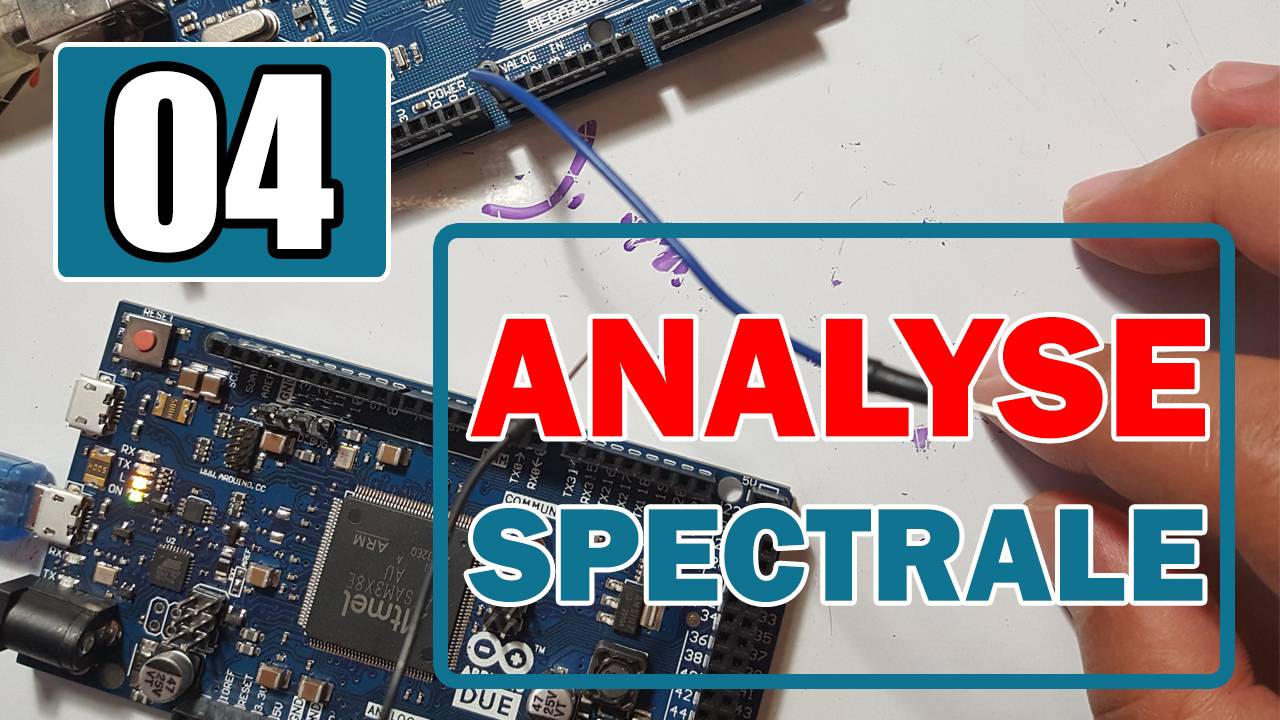Objectifs
- Savoir calculer l’amplitude d’une harmonique spécifique
- Savoir implémenter la DFT en C/Arduino
- Test de la DFT sur Arduino Mega/Due
- Analyse des performances temporelles du code sur Mega/Due
- Analyse de la DFT d’un signal sinusoïdal
- Analyse de la DFT d’une entrée réelle
- Prendre consciente du problème du sur-échantillonnage
- Etc.
Voir le tuto pour plus de détails
Applications
- Capteurs actifs (Tx, Rx)
- Linéarité
- THD
- Mesure de la FT (Fonction de Transfert)
- Contrôle non destructif
- Etc.
Programme complet
Voir le tuto pour plus de détails
#define squareOut 8 // Sortie Carrée
#define N 128 // Données N=2^n, TFD Nf=2^(n-1)
// Agit sur la Résolution fréquentielle!!!!!!!!
// df= Fs/N
#define Ts_us 500 // Ts=1/Fs: Approchée (voir le programme)
// Agit sur la fréquence MAX du spéctre!!!!!!!!
// FMXA = Fs/2
bool State=false;
unsigned long T1=0, T2=0;
float Ts=0.0, Fs=0.0;
float Data[N], Nfft=N>>1;
float dF=0.0;
float RealFFT[N>>1], ImagFFT[N>>1], ModFFT[N>>1];
float MaxIdMax[2]={0.0,0.0};
float Am, ReIm[2]={0.0,0.0};
float sMoy=0.0;
int n=0;
const double q=1.0/4096.0;
void setup()
{
// Square Out - PWM (Due) - Non utilisée
/*
pinMode(squareOut, OUTPUT);
analogWriteResolution(12); // Ajustable <= 12 (4096 Niveaux)
analogWrite(squareOut, 2048); // Pins 2-13, 1000 Hz !!
*/
// ADC
analogReadResolution(12); // Ajustable <= 12 (4096 Niveaux)
// Affichage
Serial.begin(250000);
}
void loop()
{
// 1. Lecture des données
float A0_i=0.0,A1_i=0.0;
Ts=(float)Ts_us;
for(int i=0; i<N; i++)
{
T1=micros();
A0_i=(float)analogRead(A0)+(0.5*q*rand10());
A1_i=(float)analogRead(A1)+(0.5*q*rand10());
Data[i]=(A0_i-A1_i);
Data[i]*=3.3/4096.0;
delayMicroseconds(Ts_us);
Ts+=(float)micros()-(float)T1;
Ts=Ts/2.0;
//Serial.println(1000.0*Data[i]);
}
Fs=1E6/Ts;
//Serial.println(Fs); return;
// 2. Calcul du spectre
dF=DFT(Data, N, RealFFT, ImagFFT, Fs);
// Calcul du Module de la DFT
getModul(RealFFT, ImagFFT, ModFFT, N>>1);
// Extraction de la valeur Max
ModFFT[0]=0.0;getMax(ModFFT, N>>1, MaxIdMax);
// Affichage (f0)
//Serial.print(MaxIdMax[0]); Serial.print(" \t");
//Serial.print(MaxIdMax[1]); Serial.print(" \t");
Serial.println(MaxIdMax[1]*dF);
return;
// 3. Visualisation du spectre
static bool state=false;
if(state==false)
{
Serial.println("");
for (int i=0;i<(N>>1)-1;i++)
{
if (i!=0)
{
Serial.print(dF*(float)i); Serial.print("\t");
Serial.print(2.0*1000.0*ModFFT[i]/(float)N); Serial.print("\t");
Serial.println(1000*Data[2*i]);
}
else
{
Serial.print(dF*(float)i); Serial.print("\t");
Serial.print(1000.0*ModFFT[i]/(float)N); Serial.print("\t");
Serial.println(1000*Data[2*i]);
}
}
Serial.println("");
state=!state;
}
}
float DFT(float *data, int Ndata, float *real, float *imag, float fs)
{
int nfft=floor((float)Ndata/2.0);
float df=(fs/2.0)/(float)nfft;
float somme_r=0.0, somme_i=0.0;
float wt=0.0;
for (int i=0; i<nfft; i++)
{
for (int j=0; j<Ndata; j++)
{
wt=-2.0*PI*(float)i*(float)j/Ndata;
somme_r+=data[j]*cos(wt);
somme_i+=data[j]*sin(wt);
}
real[i]= somme_r; somme_r=0.0;
imag[i]= somme_i; somme_i=0.0;
}
return df;
}
float DFTn(float *data, int Ndata, float *realImag, int n, float fs)
{
int nfft=floor((float)Ndata/2.0);
float df=(fs/2.0)/(float)nfft;
float somme_r=0.0, somme_i=0.0;
float wt=0.0;
if (n>=nfft) return 0.0;
int i=n;
for (int j=0; j<Ndata; j++)
{
wt=-2.0*PI*(float)i*(float)j/(float)Ndata;
somme_r+=data[j]*cos(wt);
somme_i+=data[j]*sin(wt);
}
realImag[0]= somme_r;
realImag[1]= somme_i;
return df;
}
void getMax(float *datain, int n, float *maxid)
{
float maxe=datain[0];
float id=0;
for (int i=1;i<n; i++)
{
if (datain[i]>=maxe)
{
maxe=datain[i];
id=i;
}
}
maxid[0]=maxe;
maxid[1]=id;
}
void getModul(float *real, float *imag, float *modul, int n)
{
for (int i=0;i<n; i++)
modul[i]=sqrt((imag[i]*imag[i]) + (real[i]*real[i]));
}
double rand10(void)
{
double rn1=2.0*((random(1e10)/1e10)-0.5);
double rn2=2.0*((random(1e10)/1e10)-0.5);
double rn=tanh((rn1-rn2));
return rn;
}
N’oublie pas de nous laisser un commentaire 🙂

